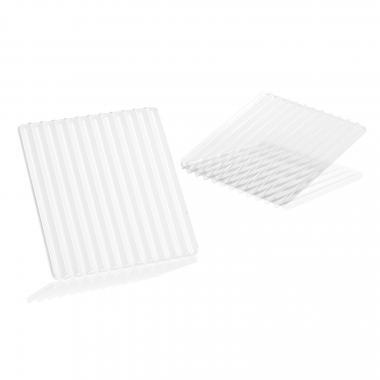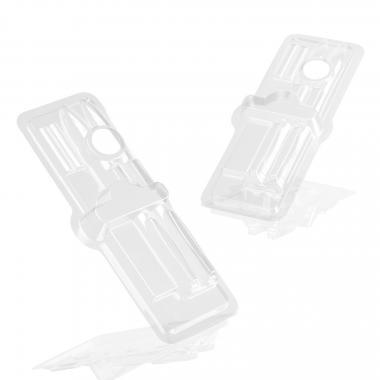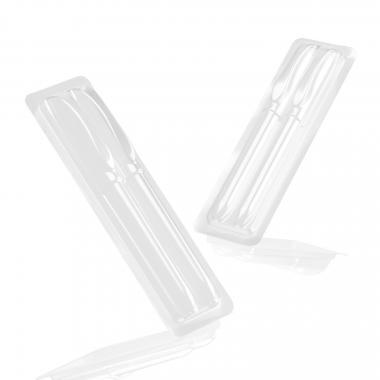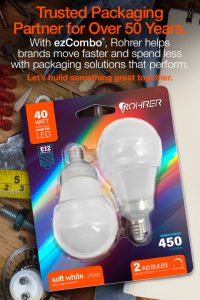Product owners, marketers, supply chain experts, and package designers find a variety of plastic material solutions across Rohrer’s thermoformed packaging programs. Thermoforming is inclusive of many types of packaging including blisters, clamshells, tri-folds, and trays.
If you would like to brush up on your blister packaging terminology, check out our recent post where we provide definitions for common blister packaging terms. Blister packaging is comprised of a thermoformed plastic part (blister) and a printed paperboard backing (blister card).
The following content includes descriptions of the most common material types, including their uses and design strengths, and other key considerations for your packaging project.
PVC (Polyvinyl Chloride) is most versatile packaging material we offer and is easily fabricated, bonded, or welded. PVC is characterized by excellent mechanical toughness, chemical and weather resistance, and flame retardant properties. PVC has more elasticity than other materials, allowing it to form well, die-cut easily, and provide better de-nesting. The elasticity also means PVC is more flexible than and not as brittle as PET. PVC can be identified by the #3 recycle symbol.
- Heat Sealing: PVC is the most forgiving with regards to heat sealing. As a result, machine efficiency increases and throughput is often better than PET. PVC works with just about every type of seal coating, including aqueous-based and solvent-based.
- Excellent for RF sealing.
- Min/Max Gauge: .010 – .045
- Our ezCombo℠ program includes 10 mil, 12 mil, and 15 mil PVC. Other gauge options are available for custom packaging projects.
- Other PVC materials:
- rPVC – Recycled PVC
- VPVC – Virgin PVC
- ESD PVC – Electro Static Dissipative PVC
- FDA PVC – Food-grade PVC
 PET or PETE (Polyethylene Terephthalate) may also be referred to as polyester. PET has excellent strength, toughness, dimensional stability, clarity, and abrasion resistance. PET is fast becoming a preferred material due to its ease of recyclability and extensive use in the food and beverage industry. Rohrer supports our partners’ green initiatives, and offers up to 100% Post-Consumer Recycled content rPET for custom thermoforming applications. PET can be identified by the #1 recycle symbol.
PET or PETE (Polyethylene Terephthalate) may also be referred to as polyester. PET has excellent strength, toughness, dimensional stability, clarity, and abrasion resistance. PET is fast becoming a preferred material due to its ease of recyclability and extensive use in the food and beverage industry. Rohrer supports our partners’ green initiatives, and offers up to 100% Post-Consumer Recycled content rPET for custom thermoforming applications. PET can be identified by the #1 recycle symbol.
- Heat Sealing: PET seals best with solvent-based coatings and select aqueous-based coatings.
- Min/Max Gauge: .010 – .045
- Our ezCombo® program includes 12 mil and 15 mil rPET. Other gauge options are available for custom packaging projects.
- Other PET materials:
- rPET – Recycled PET
- APET – Amorphous PET aka FDA PET
- FDA PET – Food-grade PET
PETG (Polyethylene Terephthalate Glycol) is similar to PET in properties and is known for its toughness, clarity, versatility, and ease to work with. The Glycol modified form of PET gives the material better impact resistance and is often used for medical applications requiring sterilization by EtO and Gamma rays. PETG can be used as an alternative to PVC when RF-sealing is required. PETG is also identified by the #1 recycle symbol.
- Heat Sealing: PETG is similar to PET with the forgiveness of PVC, and therefore works with a wider range of adhesives than PET.
- Min/Max Gauge: .010 – .045
- Available for custom packaging only. Not available in ezCombo®
- Other PETG materials:
- rPETG – Recycled PETG
- VPETG – Virgin PETG aka medical grade PETG
HIPS (High Impact Polystyrene) is a modified form of polystyrene where rubber molecules are added to give the material higher impact strength and better elongation. HIPS has a lower density than PVC and PET which results in more parts per pound when thermoformed. Typical thermoformed parts include trays, tubs, and clamshells, and it can be used when sterilization is required. HIPS is typically made to a specific PMS color but also comes in clear & natural (milky). Utility grade Black and White HIPS are widely available and offer a low-cost material option. HIPS has limited chemical resistance and has a tendency to crack when under stress.
- Min/Max Gauge: .010 – .040
- Available for custom packaging only. Not available in ezCombo®
- Other HIPS materials:
- UHIPS – Utility-grade HIPS, available in black, white, and random gray
- VHIPS – Virgin HIPS, available color match, clear, and with crystal cap
 HDPE (High Density Polyethylene) looks and feels similar to HIPS but is less brittle. HDPE has good toughness and impact resistance especially at low temperatures (it’s excellent for blast freezing). HDPE has excellent chemical resistance to fat, grease, oil, alcohol, and acids and provides an excellent moisture barrier. HDPE comes in white, black, natural, or can be custom-colored to most PMS colors. Typical applications include food trays, cups, and protective packaging. HDPE is identified by the #2 recycle symbol.
HDPE (High Density Polyethylene) looks and feels similar to HIPS but is less brittle. HDPE has good toughness and impact resistance especially at low temperatures (it’s excellent for blast freezing). HDPE has excellent chemical resistance to fat, grease, oil, alcohol, and acids and provides an excellent moisture barrier. HDPE comes in white, black, natural, or can be custom-colored to most PMS colors. Typical applications include food trays, cups, and protective packaging. HDPE is identified by the #2 recycle symbol.
- Min/Max Gauge: .010 – .050
- Available for custom packaging only. Not available in ezCombo®
PP (Polypropylene) is characterized by its excellent resistance to water, salt water, and acid solutions. PP has excellent toughness and fatigue endurance but becomes brittle at low temperatures. PP has the lowest density of the plastics used in packaging, which has contributed significantly to its growing popularity. Typical applications include food trays, clamshells, and protective packaging. HDPE is identified by the #5 recycle symbol.
- Min/Max Gauge: .010 – .050
- Available for custom packaging only. Not available in ezCombo®
- Other PP materials
- Co-Polymer PP, available in natural, white, black, or color match
- Homo-polymer PP, available in natural, white, black, or color match
We are happy to help guide you through this decision process. Let’s discuss your project and determine the right solution for your package together. If you’re new to Rohrer, visit our Contact Us page to tell us a little bit more about your project.
Don’t forget your blister card… If you’re here to explore blister packaging options, and you’ve homed in on your blister materials, it’s time to consider the right blister card solution. Check out our ezCombo® Blister Card programs here.
About the Author: Jeff Lyman, Executive Director of Business Development, has more than 30 years of plastic packaging experience. Brian Gaffney, Heat-Seal Supervisor, and Mark Tracey, Design Manager, also contributed to this report.
Rohrer offers many plastic material types for thermoformed packaging. We also design and manufacture fabricated rigid plastic folding cartons. Sign up for our blog to read a future post about the different choices for folding cartons. You can find information today visiting this page.



